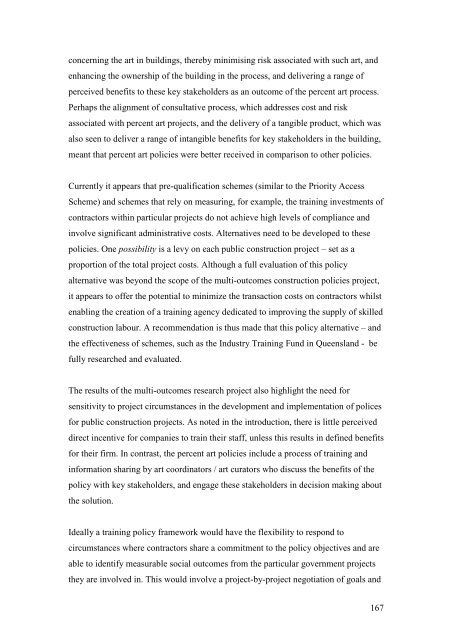Multi Outcome Construction Policy (final report)
Multi Outcome Construction Policy (final report)
Multi Outcome Construction Policy (final report)
Create successful ePaper yourself
Turn your PDF publications into a flip-book with our unique Google optimized e-Paper software.
concerning the art in buildings, thereby minimising risk associated with such art, andenhancing the ownership of the building in the process, and delivering a range ofperceived benefits to these key stakeholders as an outcome of the percent art process.Perhaps the alignment of consultative process, which addresses cost and riskassociated with percent art projects, and the delivery of a tangible product, which wasalso seen to deliver a range of intangible benefits for key stakeholders in the building,meant that percent art policies were better received in comparison to other policies.Currently it appears that pre-qualification schemes (similar to the Priority AccessScheme) and schemes that rely on measuring, for example, the training investments ofcontractors within particular projects do not achieve high levels of compliance andinvolve significant administrative costs. Alternatives need to be developed to thesepolicies. One possibility is a levy on each public construction project – set as aproportion of the total project costs. Although a full evaluation of this policyalternative was beyond the scope of the multi-outcomes construction policies project,it appears to offer the potential to minimize the transaction costs on contractors whilstenabling the creation of a training agency dedicated to improving the supply of skilledconstruction labour. A recommendation is thus made that this policy alternative – andthe effectiveness of schemes, such as the Industry Training Fund in Queensland - befully researched and evaluated.The results of the multi-outcomes research project also highlight the need forsensitivity to project circumstances in the development and implementation of policesfor public construction projects. As noted in the introduction, there is little perceiveddirect incentive for companies to train their staff, unless this results in defined benefitsfor their firm. In contrast, the percent art policies include a process of training andinformation sharing by art coordinators / art curators who discuss the benefits of thepolicy with key stakeholders, and engage these stakeholders in decision making aboutthe solution.Ideally a training policy framework would have the flexibility to respond tocircumstances where contractors share a commitment to the policy objectives and areable to identify measurable social outcomes from the particular government projectsthey are involved in. This would involve a project-by-project negotiation of goals and167
















